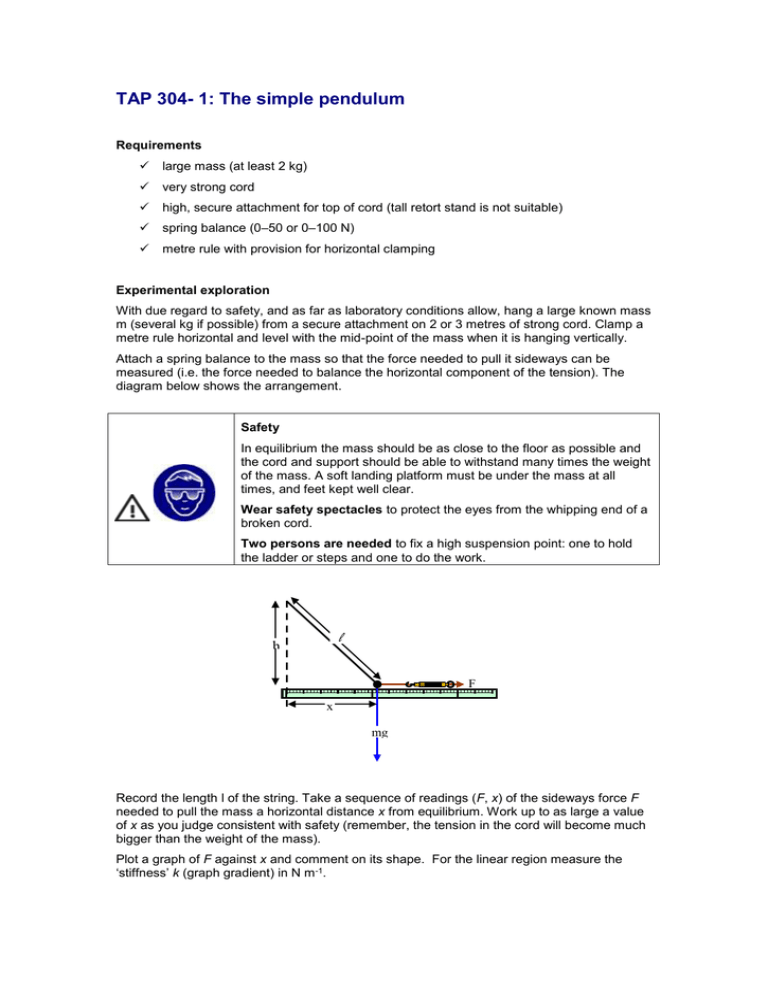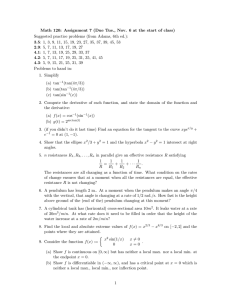Episode 304-1: The simple pendulum (Word, 57 KB)
advertisement

TAP 304- 1: The simple pendulum Requirements large mass (at least 2 kg) very strong cord high, secure attachment for top of cord (tall retort stand is not suitable) spring balance (0–50 or 0–100 N) metre rule with provision for horizontal clamping Experimental exploration With due regard to safety, and as far as laboratory conditions allow, hang a large known mass m (several kg if possible) from a secure attachment on 2 or 3 metres of strong cord. Clamp a metre rule horizontal and level with the mid-point of the mass when it is hanging vertically. Attach a spring balance to the mass so that the force needed to pull it sideways can be measured (i.e. the force needed to balance the horizontal component of the tension). The diagram below shows the arrangement. Safety In equilibrium the mass should be as close to the floor as possible and the cord and support should be able to withstand many times the weight of the mass. A soft landing platform must be under the mass at all times, and feet kept well clear. Wear safety spectacles to protect the eyes from the whipping end of a broken cord. Two persons are needed to fix a high suspension point: one to hold the ladder or steps and one to do the work. l h F x mg Record the length l of the string. Take a sequence of readings (F, x) of the sideways force F needed to pull the mass a horizontal distance x from equilibrium. Work up to as large a value of x as you judge consistent with safety (remember, the tension in the cord will become much bigger than the weight of the mass). Plot a graph of F against x and comment on its shape. For the linear region measure the ‘stiffness’ k (graph gradient) in N m-1. Use your judgement to decide the value of x above which you could consider the system nonlinear. What value of angle does this correspond to? Remember, sin = x/l Theory Either from the triangle of forces, or by resolution horizontally and vertically, show that F = mg tan From tan x/h, but provided x is not too big (small ), h (which is of course variable) is approximately the same as l (which is constant), so that tan = x/l Hence F = mgx/l Another way of arriving at this is to use the small angle approximation that tan sin for small . You can now see how good the approximation of linearity is – it is as good as you want it to be. For = 100 the difference between tan and sin is 1.5% of sin For = 200 the difference becomes 6.4% For = 300 the difference becomes 15% You can see that the theoretical ‘stiffness’ k is mg/l (for the linear region). Calculate this value and compare it with the value from the graph. An interesting property of a pendulum is that its period is also independent of its mass. Look at the theoretical expression for k and see if you can see why this should be. Practical advice Students measure the restoring force on the bob of a simple pendulum when it is displaced by different amounts. They then use trigonometry and the small angle approximation to derive an expression for the period of small-amplitude oscillations and consider what is meant here by ‘small’. Safety In equilibrium the mass should be as close to the floor as possible and the cord and support should be able to withstand many times the weight of the mass. A soft landing platform must be under the mass at all times, and feet kept well clear. Wear safety spectacles to protect the eyes from the whipping end of a broken cord. Two persons are needed to fix a high suspension point: one to hold the ladder or steps and one to do the work. External reference This activity is taken from Salters Horners Advanced Physics, section BLD, additional sheet 4



